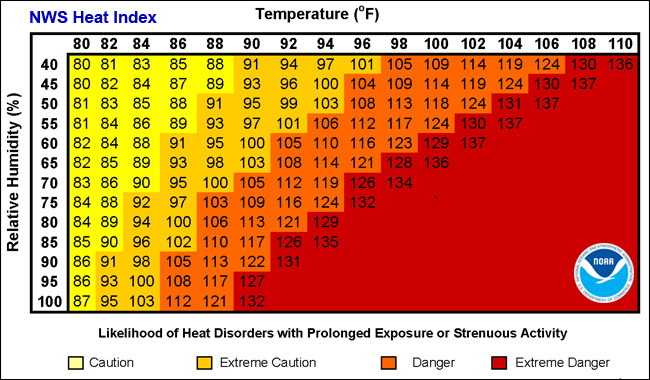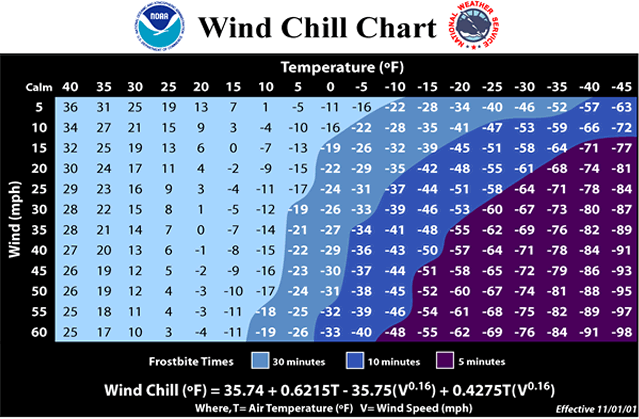When watching a typical weather forecast, the TV meteorologist will often refer types of temperatures. In addition to simply stating the temperature, they will refer to other metrics such as the heat index, wind chill, feels like or RealFeel temperature. What is the difference between these values and why do we have them?

Why make the temperature more complex?
Simple ‘temperature’ is a measure of how cold or hot the air is. Normally it’s measured at a height of two meters (six feet) to match the height of the average human – temperatures near the ground can vary quite considerably as the sun warms the ground or cools at night.
However the human body handles the ambient temperature is not simply a factor of the temperature. The human body must regulate the temperature so that it gets neither too hot or cold. Let’s take a look how the body handles high or low temperatures.
How the body regulates high temperatures
When it gets very warm, the body sweats, producing moisture on the skin. The evaporation of the sweat into the surrounding atmosphere uses heat energy. This energy comes from body’s skin and so the evaporating sweat removes heat energy from the skin causing the body to cool down.
The ability for the sweat to evaporate is highly dependent on the temperature and amount of water in the surrounding air. The amount of water in their air is referred to as ‘humidity’ and is measure of how much water vapor the air can hold for that temperature. When the air is high in humidity, the air cannot hold much more water vapour and so it is difficult for the sweat to evaporate. In this situation, sweating is less effective at cooling the body. Therefore, high humidity makes it harder for the body o keep cool and so makes it feel hotter.
How the body regulates low temperatures
When it is cold, animals try to protect themselves from the colder air by insulating themselves. Birds and animals may fluff up their fur to help trap a layer of air to provide insulations. Humans have developed clothes – when it is cold we wrap up warm with extra coats, scarfs and gloves.
Just like in hotter temperatures, other atmospheric factors will make it feel colder or warmer. In particular, wind make it easier for the warm body heat to transfer into the surrounding air by replacing the air around the body with cold air. When the wind is strong, the air around the body, which would warm on a still air as it absorbs air from the body, is continually replaced and so it feels colder.
Heat index and wind chill
Heat index and wind chill are therefore measures that combine weather values to make it feel hot or cold. They are a measure of how hard the body will work to keep warm or keep the body cool. They also help give an easy-to-understand way to communicate the dangers of conditions that are forecast.
Note that heat and wind chill index are by definition dimensionless (i.e. they are not a calculation resulting in a value of degrees fahrenheit or celsius). However they are a calculation that results in a temperature-like value, making it easy for public consumption.
Heat Index
Heat index combines the predicted temperature with the predicted humidity. For the same temperature, as the humidity increases, the heat index will increase.

For example for a temperature of 90F, the heat index will increase to 127F if the humidity is raised to 95%. While a temperature of 90F is not dangerous to most people, if the body cannot regulate heat because of 95% humidity, then the chart shows that the heat index is dangerous and could cause heat stroke or other heat-related disorders.
Wind chill
Wind chill combines the predicted temperature with the predicted wind speed to calculate how cold it will feel. As the wind speed increases, the chilling factor of the wind will increase, making it feel colder.

For example, for a temperature of 20F, if the wind speed increases to 35 miles per hour, the temperature outside will actually feel like 0F.
Are heat index and wind chill temperatures real temperatures? Can an object cool to the wind chill temperature or heat to the heat index?
The heat index and wind chill temperatures are not temperatures to which an object could be heated or cooled by the ‘heat index’ or ‘wind chill’ values. They are representation of the apparent temperature difference from the human body temperature. The further the surrounding temperature is away from the body temperature (around 98.2F), the more the body will feel that it is hot or cold.
This temperature difference influences the rate of heat exchange. Very cold air will absorb heat from the body more quickly than warmer air. The heat index and wind chill are therefore more of an indication of the apparent temperature difference. An object will not heat or cool beyond the actual air temperature. It will cool more quickly because the wind keeps the air surrounding the object cold and so keeps a high temperature differential. Heat index is a little trickier as inanimate objects don’t typically sweat!
As the body generally will maintain the same temperature in spite of the surrounding air temperature, the temperature gradient is highly dependent on the rate of transfer of heat to or from the body.
Feels like temperature
In Visual Crossing Weather Data, we use the feels like temperature to combine the heat index, normal temperature and wind chill into a single value indicating how hot or cold it will feel. If the heat index is high, then the feels like temperature will be governed by the heat index. If the wind chill is low, the feels like temperature will be a measured by the wind chill. Between these two extremes, the feels like temperature will be measured by the actual temperature.
Other apparent temperature measures
Different weather providers have different names and methodologies for calculating the apparent temperature. Accuweather has the ‘RealFeel’ temperature that includes the cloud cover and angle of sun. Some countries and organizations uses the same methodologies described above but use different terminology such as the ‘Relative outdoor temperature’ or the Canadian ‘humidex’ (short for humidity index).
Questions or need help?
If you have a question or need help, please post on our actively monitored forum for the fastest replies. You can also contact us via our support site or drop us an email at support@visualcrossing.com.
